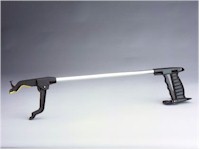After Beginning the semester project, I thought it was important to investigate and understand several key concept related to said project. These include the concept of sensing the news as well as understand gesture controlled interactions. The following Blog post hopes to show some of my exploration into the topic.
1. Children's Intuitive Actions
Before we get too far into it, this research is an older study, some details may be out of date. However, what makes this topic great is the concepts and themes that it covers.
The study itself shows how to go about synthesising qualitative data from potential users and turn it a standardised tangible interaction. This is shown below
This shows how the children have a common understanding of a particular interactions. Once the common understanding is gathered, the interaction within the video game can be created. This process of understanding interactions and synthesising them into a product is a good example of how to achieve this product.
2. A Research Paper into the Topic
Gesture-controlled user interfaces, what have we done? and what's next?
by Moniruzzaman Bhuiyan and Rich Picking
This document helps outline what advances have been made in the history of guesture-based interaction design, but more importantly, what research and advancement needs to be done next.
The article itself, is critical on the research and development on gesture design so far. They authors believe that too much focus has been based on hand and head gestural interactions as apposed to the myriad of other behaviours and motions humans generally make.
The article also says that research into gestural interaction in the past was focused on generic users. However, it complimented that research was moving further into accessibility and enabling easier use for those who need it. This universal design principle is allows suitable interaction for everyone!
3. Example: Gesture CubeAs this project centres on the topic of gestural interaction, I though it would be interesting to investigate a project out there that claims to be leader in gestural interaction.
My first opinion of this product is the use of mapping and understanding gestures in three dimensional space. This, I believe, will enable a better "interactive quality, as interaction data is transmitted in a continuous way, rather than a discrete or On/Off Manner.
Secondly, I believe this product is well designed to help in the transition from standard to gestural interfaces. I think this works well because the product is designed as a box, with interfaces on all side. The fact that this product is a tangible object that sits in obvious three-dimensional space, intuitively suggests interaction. This is in comparison to several other concepts out there. which just use camera technology and interaction with the user from one side.
This is also displayed through when the user flips through pages on the Gesture Cube. The user had to lift the "pages" up and across in space, while some gestures include a rather less intuitive swipe across a interface, which can be confused when performing other interactions.
Thirdly, the product is will be successful as, from what I can, it is a well designed product. The product doesn't lose usability and features for sake of interaction. Eg. how the cube locks when you pick it up.
4. An Example of A Company Using These technologies at Present.
Mechdyne:
Mechdyne represent a company currently producing real interactive design solutions.
These include a variety of 3D and 2D walls, portable options and tiled electronic walls. These interactive displays may not be perfect, but they're real proven concepts. These are controlled through gestural interactions.





































